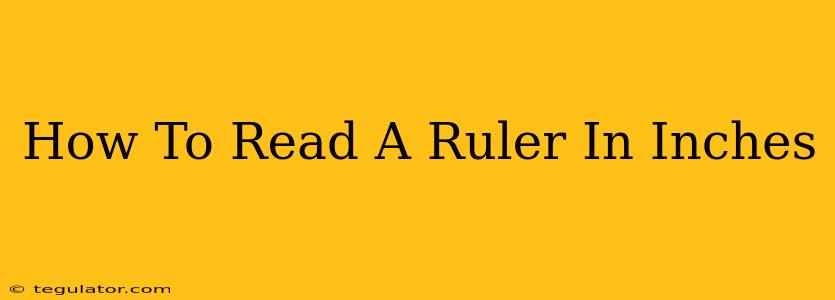Measuring accurately is crucial in various tasks, from crafting and woodworking to sewing and home improvement projects. Understanding how to read a ruler in inches is a fundamental skill. This guide provides a step-by-step approach to mastering this essential measurement technique.
Understanding the Ruler's Markings
A standard inch ruler is divided into 12 inches. Each inch is further subdivided into smaller units, typically:
- Halves (1/2 inch): The longest markings after the inch markings.
- Quarters (1/4 inch): The next longest markings.
- Eighths (1/8 inch): Slightly shorter markings.
- Sixteenths (1/16 inch): The shortest markings on most rulers.
Some rulers may even include thirty-seconds (1/32 inch) and sixty-fourths (1/64 inch) markings for even more precise measurements.
Step-by-Step Guide to Reading a Ruler in Inches
-
Identify the Inches: Locate the larger numbered markings representing whole inches. These are usually clearly labeled.
-
Determine the Fractional Part: Focus on the markings between the whole inches. The length you're measuring will likely fall between two whole numbers.
-
Match the Markings: Identify the longest marking that aligns with the end of the object you're measuring. This determines the largest fractional part (1/2, 1/4, etc.).
-
Add the Smaller Markings: If the object extends beyond the longest marking, count the smaller markings (1/8, 1/16, etc.) to find the additional fractional part.
-
Combine Whole and Fractional Parts: Add the whole inch measurement to the fractional measurement to get the total length in inches.
Example: Measuring a Pencil
Let's say you're measuring a pencil. The end of the pencil aligns with the "2" inch marking, and then extends to the third 1/8-inch marking beyond the "2". This means the pencil measures 2 and 3/8 inches (2 3/8").
Tips for Accurate Measurement
-
Proper Alignment: Ensure the end of the object you are measuring is perfectly aligned with the "0" inch marking on the ruler.
-
Eye Level: Keep your eye directly above the end of the object to avoid parallax error (the apparent shift in the position of an object when viewed from different angles).
-
Practice Makes Perfect: The more you practice using a ruler, the more comfortable and accurate you'll become.
Beyond Basic Inch Measurements
Understanding basic inch measurements is a foundation for more advanced measuring techniques. This skill is invaluable for:
- DIY Projects: Building furniture, crafting, and home repairs often require precise measurements.
- Sewing and Quilting: Accurate measurements are crucial for creating well-fitting garments and quilts.
- Technical Drawings: Reading blueprints and technical drawings often involves working with inches and fractional measurements.
Mastering the art of reading a ruler in inches empowers you to confidently tackle numerous projects and tasks. With consistent practice and attention to detail, you'll quickly develop the skills needed for accurate measurements.

